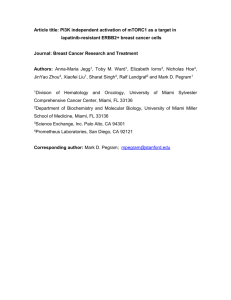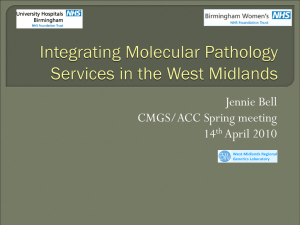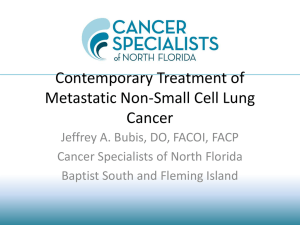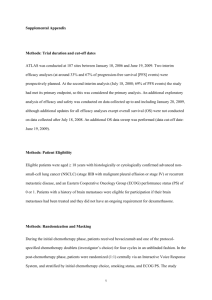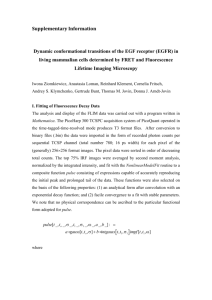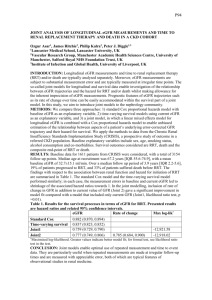Manuscript - Broad Institute
advertisement
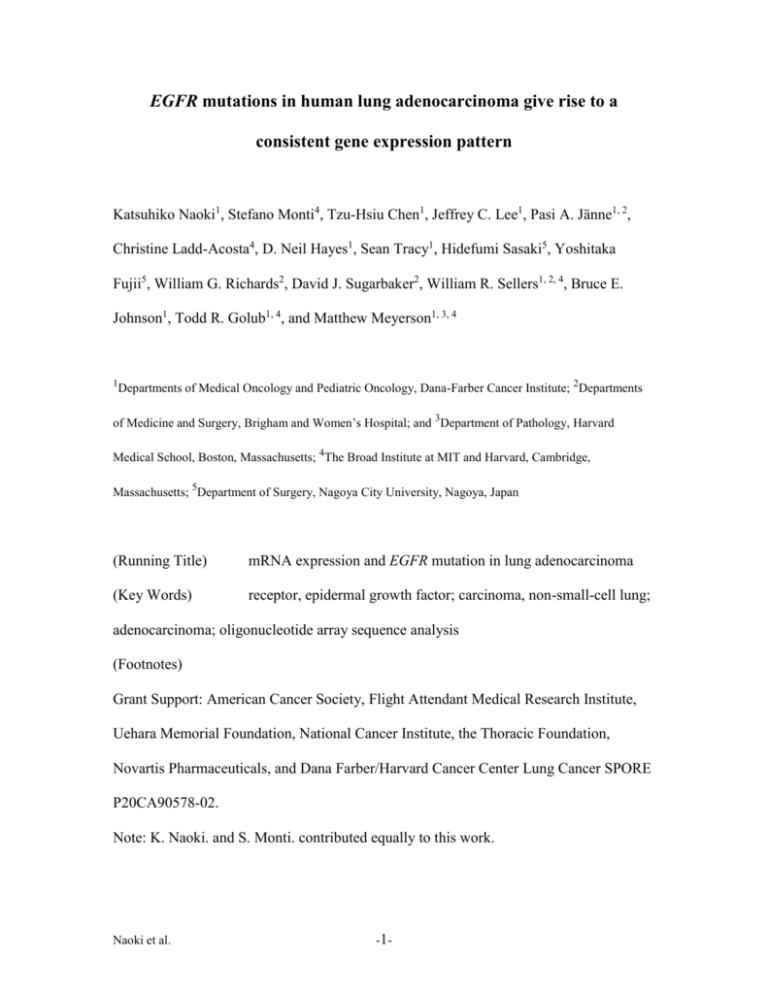
EGFR mutations in human lung adenocarcinoma give rise to a consistent gene expression pattern Katsuhiko Naoki1, Stefano Monti4, Tzu-Hsiu Chen1, Jeffrey C. Lee1, Pasi A. Jänne1, 2, Christine Ladd-Acosta4, D. Neil Hayes1, Sean Tracy1, Hidefumi Sasaki5, Yoshitaka Fujii5, William G. Richards2, David J. Sugarbaker2, William R. Sellers1, 2, 4, Bruce E. Johnson1, Todd R. Golub1, 4, and Matthew Meyerson1, 3, 4 1 Departments of Medical Oncology and Pediatric Oncology, Dana-Farber Cancer Institute; 2Departments of Medicine and Surgery, Brigham and Women’s Hospital; and 3Department of Pathology, Harvard Medical School, Boston, Massachusetts; 4The Broad Institute at MIT and Harvard, Cambridge, Massachusetts; 5Department of Surgery, Nagoya City University, Nagoya, Japan (Running Title) mRNA expression and EGFR mutation in lung adenocarcinoma (Key Words) receptor, epidermal growth factor; carcinoma, non-small-cell lung; adenocarcinoma; oligonucleotide array sequence analysis (Footnotes) Grant Support: American Cancer Society, Flight Attendant Medical Research Institute, Uehara Memorial Foundation, National Cancer Institute, the Thoracic Foundation, Novartis Pharmaceuticals, and Dana Farber/Harvard Cancer Center Lung Cancer SPORE P20CA90578-02. Note: K. Naoki. and S. Monti. contributed equally to this work. Naoki et al. -1- Requests for reprints: Matthew Meyerson, Department of Medical Oncology, DanaFarber Cancer Institute, room M430, 44 Binney Street, Boston, MA 02115. Phone: (617) 632-4768; Fax (617) 582-7880; E-mail: matthew_meyerson@dfci.harvard.edu. Naoki et al. -2- Abstract Mutations of the epidermal growth factor receptor (EGFR) gene have recently been identified in human lung cancers and are associated with clinical response to gefitinib treatment. We sought to determine the pattern of EGFR mutations in lung adenocarcinomas from the United States and the relationship between EGFR mutations and mRNA expression profiles. Analyses of EGFR kinase domain sequence from 127 lung adenocarcinomas from U.S. patients revealed mutations in 13 tumor specimens (10%). A majority of the specimens with EGFR mutations fall into several distinct adenocarcinoma sub-groups as previously defined by unsupervised clustering of gene expression data. Supervised analysis of gene expression data revealed higher expression of several downstream targets of the EGFR pathway, as well as of EGFR itself, in tumors with EGFR mutation. The genes associated with EGFR mutation in the original data set were likewise enriched in the 14/29 specimens with mutant EGFR in an independent set of lung adenocarcinomas from Japan. The consistency of gene expression profiles in both populations suggests that lung adenocarcinomas with EGFR mutation form a biologically distinct subset. Naoki et al. -3- Introduction Recent studies have revealed somatic missense mutations in the kinase domain of the epidermal growth factor receptor (EGFR) gene in a significant fraction of primary non-small cell lung cancers (1, 2). EGFR mutations were reported in 3 / 86 (3%) unselected non-small cell lung cancers from patients in the United States and in 15 / 58 (26%) unselected non-small cell lung cancers from patients in Japan. Treatment of patients with non-small cell lung cancer with the EGFR kinase inhibitor gefitinib (IressaTM) has led to clinical responses in approximately 10-20% of patients. Clinical characteristics associated with response and longer survival after gefitinib treatment include female gender, a non-smoking history, diagnosis of adenocarcinoma especially with bronchioloalveolar features, and Japanese nationality (36). Mutations in the kinase domain of the EGFR gene appear to account for the increased sensitivity of some non-small cell lung cancers to treatment with gefitinib. Specifically, EGFR kinase domain mutations were reported in a total of 13 of 14 lung adenocarcinoma specimens from gefitinib-responsive patients, but in none of 10 nonresponsive lung adenocarcinomas from gefitinib-insensitive patients (1, 2). To determine the frequency of EGFR mutations in a large unselected population of resectable lung adenocarcinomas from U.S. patients and to analyze the gene expression characteristics of lung adenocarcinomas with EGFR mutations, we have analyzed EGFR mutations in a set of lung adenocarcinomas from patients treated in the United States that were previously characterized according to gene expression profiling and unsupervised clustering (7) as well as sequencing for somatic mutations of KRAS and Naoki et al. -4- BRAF (8). The profiles of lung adenocarcinomas with EGFR mutations were compared with an independent data set of lung adenocarcinomas from Japan characterized by expression profiling and EGFR sequencing. This allowed us to compare the mRNA expression profiles in two different ethnic populations with different frequencies of EGFR mutations. . Naoki et al. -5- Materials and Methods Tumor and RNA specimens Lung adenocarcinoma samples from the Brigham and Women’s Hospital Thoracic Surgery tumor bank and RNA preparation methods have been previously described (7). The lung adenocarcinoma samples from Nagoya City University in Japan have also been previously described (1). We performed expression microarray analysis of 22 adenocarcinoma samples from this previous report (1) for which RNA samples were available. We also performed both EGFR and KRAS sequencing as well as RNA expression profiling on 7 additional lung adenocarcinoma samples from Nagoya City University that have not been previously reported. . All tumor samples were obtained and experiments were performed under protocols approved by the institutional review board of each institute. The age, gender, stage, smoking status, and outcome of the patients were collected as previously described (1) (7). We also analyzed mRNA expression data from 10 lung cancer cell lines (NCI-H1650, NCI-H1666, NCI-H1781, NCI-H23, NCI-H2347, NCI-H3122, NCI-H3255, NCI-H358, NCI-H441, and A549) that have been studied for EGFR mutation and their sensitivity to gefitinib (9). NCI-H1650 and NCI-H3255 have been previously shown to have mutations in the tyrosine kinase domain of EGFR (1, 10). RT-PCR, Genomic DNA PCR, and DNA Sequencing Total RNA from lung cancer specimens was used to generate complementary RNA (cRNA) by in vitro transcription (7). The cRNA and/or total RNA was used as Naoki et al. -6- template for reverse transcription-PCR (RT-PCR) amplifications of kinase domain of EGFR (exon 18 to exon 24). The primer sequences have been described (1). RT-PCR was performed using Superscript One-Step RT-PCR with a Platinum Taq kit (Life Technologies, Gaithersburg, MD). A single 50 l RT-PCR reaction mix contained 1 g of cRNA, 3mM MgSO4, 100 pmol of each primer, and 1 l RT / Platinum Taq mix. RT-PCR was carried out as described (1). We also analyzed KRAS codon 12, 13, and 61 mutations using cRNA or total RNA samples with RT-PCR. Amplification was done using specific primers (forward: CGGGAGAGAGGCCTGCTGA; reverse: CCACTTGTACTAGTATGCCTTAAGAA). Conditions were the same as above. The BRAF gene was sequenced as previously described and reported (8). For samples with mutations detected at the cDNA level, we isolated genomic DNA from frozen specimens of uninvolved normal lung controls, using the QIAamp DNA Mini Kit (QIAGEN, Chatsworth, CA) according to the manufacturer’s instructions. EGFR genomic DNA was amplified and sequenced as previously described (1). RT-PCR and PCR products were purified using the QIA quick purification kit (QIAGEN, Chatsworth, CA) or SPRI (Solid phase reversible immobilization) chemistry. Purified products were subjected to primer extension sequencing (11) in both forward and reverse directions, by either the Molecular Biology Core Facility at Dana-Farber Cancer Institute or Agencourt Bioscience Corporation (Beverly MA). Forward and reverse chromatograms were analyzed by Sequencher software (Gene Codes Corporation, Ann Arbor, MI) or by Mutation Surveyor 2.03 (SoftGenetics, State College, PA). Naoki et al. -7- Expression profiling Processing of expression data of Brigham and Women’s Hospital samples have been previously described (7). These data were obtained from HGU95Av2 arrays (Affymetrix, Santa Clara, CA). RNA samples from the Nagoya tumors were processed and hybridized to HGU133A 2.0 arrays (Affymetrix, Santa Clara, CA), RNA samples from lung cancer cell lines were processed and hybridized to HGU95Av2 arrays (Affymetrix, Santa Clara, CA) according to the manufacturer’s instructions. Normalization and scaling of all three sets of samples was carried out as described in (7) based on the dChip program (12). Differential analysis In both datasets, gene expression values were compared between the EGFR mutant lung adenocarcinomas and the lung adenocarcinomas documented to be wild type for EGFR. In particular, a variation filter was first applied so as to select genes with median expression (in arbitrary Affymetrix expression units) greater than 20 and with median absolute standard deviation of gene expression units greater than the 50th percentile for all genes. From within this gene pool, genes correlating with the class distinction of interest (wild type = 1 vs. mutant = 2) were identified by ranking them according to their signal-to-noise ratio (SNR). For a given gene g, SNR (g) = ( x 1 – x 2)/(s1 + s2), where x i and si denote, respectively, gene g's sample mean (or median) and sample standard deviation within class i = 1, 2. A Monte Carlo simulation of the permutation distribution of the signal-to-noise ratios was performed by permuting the sample labels indicating class membership (n = 1000); thereafter, the observed values in the data were compared with the 99th percentile of the permutation distribution. Naoki et al. -8- Cross-platform analysis The EGFR gene expression signatures identified in the two datasets were compared based on a Kolmogorov-Smirnoff (KS) rank test as described (13). In particular, the total list of genes present in one dataset (e.g., the Nagoya data) was ranked according to the signal-to-noise ratio with respect to the “mutant vs. wild type” signature; the top n up-regulated EGFR genes in the second dataset (e.g., the Brigham and Women’s Hospital data) were located within the ranked list and their proximity to the genes with higher levels of expression in the mutant class was measured by a KS score (with a higher score corresponding to a higher proximity). An empirical p-value for the observed KS score was computed by comparing it to the distribution of KS scores obtained by permutation of the class labels and corresponding re-ranking of the list of genes. A similar procedure was used to place the set of down-regulated mutant genes in one dataset within the list of genes ranked according to the “wild type vs. mutant” signature in the other dataset. We selected n=300 as the number of up- (down-) regulated genes defining the gene set to test for enrichment. Selection of a different number n of genes did not change the significance of the results (data not shown). Naoki et al. -9- Results and Discussion Mutation frequency of EGFR in primary lung adenocarcinomas from the United States To determine the frequency of mutations in the EGFR gene in unselected U.S. lung adenocarcinomas, we sequenced the kinase domain from the 127 lung adenocarcinomas of U.S. origin characterized by gene expression analysis (7). Among these tumors, we detected a higher frequency of EGFR mutations (13/127, 10.2%; Table 1 and Supplementary Fig.1) (1). This frequency is consistent with the rate of clinical response to gefitinib treatment in U.S.-based clinical trials (3, 6, 14). EGFR mutations are summarized in Table 1A. Five human lung adenocarcinomas have the missense mutation L858R or L861Q in exon 21 and six samples have in-frame deletion mutations in exon 19. We have also found several novel mutations. Two tumor samples contain in-frame insertions in exon 20, and one sample has a missense mutation (G779S) in exon 20 as well as the L861Q mutation. All mutations were shown to be somatic, except for one specimen in which the sequencing of normal control tissue failed. Clinical characteristics of patients with EGFR mutations In this sample set of lung adenocarcinomas of U.S. source, the relationship between EGFR mutations, gender, and smoking status is striking (Table 1B). Only one adenocarcinoma from 46 men (2%) had a mutation of EGFR, compared to 10 of 69 (14%) of adenocarcinomas from women with mutations in EGFR (the information regarding gender as well as smoking status was anonymized in 12 out of the 127 patients). One half of the 12 adenocarcinomas (6/12) from women who did not smoke Naoki et al. -10- have mutations of EGFR while the rest are wild type. Two of two adenocarcinomas from men who did not smoke have wild type EGFR. In contrast, KRAS mutations are found in a similar rate both in adenocarcinomas from female patients (30%, 21/69) and from male patients (41%, 19/46). All of the 12 adenocarcinomas from non-smoking women were wild-type for KRAS. We compared the outcome of patients whose lung adenocarcinomas contained wild type or mutant EGFR (Fig. 1A and Supplementary Fig.2). The median survival time of patients with EGFR mutant adenocarcinomas (n=11) was 57.8 months and that of patients with wild type EGFR (n= 103) was 41.2 months (Fig 1A; no outcome information available for 13 of 127 anonymized patients). The difference in survival is not statistically significant (p = 0.41, log rank test). Patients with KRAS mutant adenocarcinomas (n=40) had a median survival of 41 months while patients with KRAS wild-typed adenocarcinomas (n=74) had a median survival of 48 months (Fig 1B). Again, this difference was not statistically significant (p=0.67, log rank test). These results are similar when only stage I tumors are considered (Supplementary Fig.2). There are also confounding factors of age, gender, and variations in treatment; as patients and samples were anonymized in 2000 and 2001, further follow-up information (including possible gefitinib treatment) is not available. EGFR mRNA expression To analyze the expression of multiple genes as a consequence of EGFR mutation, we examined the data obtained by hybridizing the RNA from each tumor to Affymetrix oligonucleotide arrays. As a first effort to determine the genes affected by EGFR Naoki et al. -11- mutation, we compared the mean expression of EGFR mRNA between the mutant and wild-type tumors. On average, EGFR expression was significantly higher in adenocarcinomas with EGFR mutations compared to the wild type EGFR as measured by 2 probe-sets on the Affymetrix U95Av2 expression arrays (Fig. 2; p=0.0065 and p=0.0014, two-sided t test). However, the ranges are overlapping and the highest individual levels of EGFR mRNA expression were noted in adenocarcinoma specimens with wild type EGFR. EGFR copy number and EGFR mutations may be related to the mRNA expression. Hirsch et al (15) reported that EGFR gene copy number correlated with EGFR protein expression, but not with prognosis in a cohort of patients not treated with gefitinib. Some of our samples with wild type EGFR may have high copy number as well because elevated levels of EGFR mRNA. Further study will be needed to delineate the relationships among EGFR mutation, EGFR gene copy number, EGFR mRNA expression, and EGFR protein expression. EGFR, KRAS and BRAF mutations are mutually exclusive in lung adenocarcinoma As KRAS and BRAF are downstream targets of EGFR and are mutated in lung adenocarcinoma, we checked the mutation status of EGFR, KRAS and BRAF in all lung adenocarcinomas with gene expression data (7) (Table 1C and Fig. 2). The frequency of KRAS mutations was 34.6% (44 of 127), similar to that reported in the literature (16-20). In these lung adenocarcinomas, EGFR, BRAF and KRAS mutations were mutually exclusive and were not present in the same tumor specimen. This does not exclude the possibility that additional lung adenocarcinomas may show mutation of more than one of Naoki et al. -12- these genes, but the mutually exclusive relationship suggests that they may be functioning within the same oncogenic pathway, consistent with known signal transduction mechanisms. Relationship between EGFR, KRAS and BRAF mutation status and gene expression Unsupervised clustering of gene expression data revealed that the majority of EGFR mutants were clustered in three adenocarcinoma sub-groups (Figure 2A). There are four major clusters (C1 through C4) and three groups with weaker association (Group I, II and III) defined in our previous study (7). The 13 samples with EGFR mutation were mainly clustered in either one small cluster adjacent to Group I, with high relative EGFR expression, or in the closely-related Group III and C4 (Fig. 2A). As previously described for the C4 class (7), which comprises many of the EGFR mutant adenocarcinomas, EGFR mutation is associated with bronchioloalveolar carcinoma (BAC) features in this data set; 7/13 samples with EGFR mutation have BAC features according to at least one of three pathologists who examined the tumors. With unsupervised and supervised analysis of microarray data, there is a cluster of adenocarcinomas with both wild type EGFR and wild type KRAS (Fig. 2A and B), closely related to the formerly defined C1 class (7). Large scale sequencing efforts (1, 21) may reveal additional targets of therapy in this and other groups. Gene Expression analysis – genes correlated with EGFR mutations Differential analysis of transcriptional profiles was carried out to identify gene expression correlates of EGFR mutation. The genes were sorted by their degree of Naoki et al. -13- correlation with the “mutant vs. wild type” distinction according to a median-based signal-to-noise metric (see "Materials and methods"). Permutation of the sample labels indicated that mutant samples had significantly lower expression of more than 30 genes and significantly higher expression of more than 1000 additional genes, compared with wild type samples (P < .01) (Supplementary Fig. 3). Among the significantly upregulated genes were several known downstream targets of EGFR pathway in EGFR mutants (Supplementary Table 1), such as RSK (ribosomal protein S6 kinase, p90, polypeptides 1 and 3) (22-27), JAK1 (28), filamin A (27), SOS (26, 29), SLC9A1 (NHE1) (30, 31), calpain-2 (32, 33), and MAPK8IP3 (JSAP1) (34). Among the top genes on our list are the genes encoding RSK subunits, which are located downstream of the RAF-MEK-ERK pathway. RSK has many substrates, which include filamin A (27), SOS (26), and SLC9A1 (NHE1) (31) among the top 50 genes in terms of correlation to EGFR mutation. RSK is worth investigating for its role in EGFR signaling, as a potential therapeutic target in lung adenocarcinoma and as a candidate for gene mutation in tumors with wild-type EGFR. Another interesting gene is calpain-2, which is shown to be activated by EGFR (32) and to contribute to alterations in cell motility, proliferation, and apoptosis (33). To determine the statistical significance of the similarity of the “mutant vs. wild type” signatures in the two datasets we performed enrichment tests based on the Kolmogorov-Smirnoff rank statistic. We selected the top 300 up-regulated genes in the U.S. source EGFR mutants using data from U95A human gene expression arrays, mapped the probes for these genes to the U133A array platform, and tested for their enrichment in the Japan source mutant signature (see “Materials and methods”, Fig. 3 and Naoki et al. -14- Supplementary Table 2). When compared with repeated random class labelings (N=1000), the Kolmogorov-Smirnov (KS) score indicated that the observed U.S.-Japan similarity was highly significant (mean-based analysis: p=0.004, median-based analysis: p=0.007, Figure 3A). Performing a similar procedure in the opposite direction (selecting the set of top 300 up-regulated genes in the Japan source EGFR mutants and testing this set in the U.S. data) also yielded a highly significant KS score (mean-based analysis: p=0.003, median-based analysis: p=0.006, Figure 3B). In the Japanese patients, there are two patients with KRAS mutations in an EGFR wild type background but none in the EGFR mutant background, showing that EGFR and KRAS mutations are mutually exclusive as in US patients. One of our initial goals was to develop an expression-based classifier that would distinguish lung adenocarcinomas with mutant from those with wild-type EGFR. Our efforts to date to accomplish cross-platform clustering between U95 and U133 arrays, using several different approaches including k-nearest neighbors, weighted voting, and KS analysis, have all maintained error rates in the 15% to 25% range. As one goal of such a classifier would be to develop a pre-selection for tumors that should be sequenced for EGFR, this error rate appears to be too high for practical utility. We also sought to delineate the statistical significance of the similarity of the “mutant vs. wild type” signatures in the cell line datasets. We obtained U95Av2 data from a panel of 10 cell lines, two of which have EGFR mutations (NCI-H1650 has del746-750 deletion and NCI-H3255 has the L858R missense mutation) while the remainder are EGFR wild type. We performed enrichment tests based on the Kolmogorov-Smirnoff rank statistic. We selected the top 300 up-regulated genes in the Naoki et al. -15- U.S. source patients with EGFR mutation and tested for their enrichment in the cell line mutant signature. Although not statistically significant, the tendency of the enrichment was similar (Figure 3C). In summary, microarray analysis of different populations (U.S. vs. Japanese source) and different specimen types (tumor vs. cell lines) has revealed characteristic gene expression correlates of gefitinib–responsive EGFR mutations within human lung adenocarcinomas. A subset of the genes that are up-regulated in the adenocarcinomas with EGFR mutations are themselves down-stream targets of EGFR, suggesting a significant biological role for these expression alterations. In addition, this work has defined the frequency of EGFR mutations in unselected U.S. lung adenocarcinoma patients as approximately 10%, consistent with the rate of response to gefitinib in this population. Acknowledgments We thank Dr. Heidi Greulich for the critical review of the manuscript and helpful discussion. Naoki et al. -16- Figure Legends Fig. 1. Kaplan-Meier curves of survival by mutation status for lung adenocarcinoma patients. A. Survival of patients with EGFR mutations versus patients with a normal EGFR sequence. B. Survival of patients with KRAS mutations versus patients with a normal KRAS sequence. The circles represent censored patients. Fig. 2. EGFR expression vs. EGFR mutation status in lung adenocarcinoma. Mean expression of EGFR mRNA was significantly higher in adenocarcinomas with EGFR mutations compared to the wild-type EGFR as measured by 2 probe sets on the Affymetrix U95Av2 expression arrays. A, 1537_at (EGFR): p=0.0065, B, 37327_at (EGFR): p=0.0014 (two-sided t test). Fig. 3. Dendrogram of lung adenocarcinoma with reference to EGFR mutation. A, Unsupervised expression-defined adenocarcinoma subclasses (7). There are four major clusters (C1 through C4) and three groups with weaker association (Group I, II and III). Samples of normal lung (NL) were not included in this EGFR mutation search. The 13 samples with EGFR mutation were mainly clustered in either one cluster in left side or in a cluster closely related to Group III and C4. Please note that this figure is adapted from ref. (7). B, Supervised clustering of U.S. lung adenocarcinoma samples in space of top 200 markers (median base) / class (mutant vs. wild type). Notably there is a cluster both EGFR wild type and KRAS wild type. Naoki et al. -17- Fig. 4. Correlation of mRNA expression with EGFR mutation in U.S. and Japan lung adenocarcinoma patients and lung cancer cell lines (Enrichment test). U.S. vs. Japan. A. Mean-based, B. Median-based signature. Selected the top 300 EGFR mutation markers in U.S. source data (U95Av2 Affymetrix Genechip). Mapped to U133A Affymetrix Genechip, 252 remain (258 for median). Tested on Japan source data (U133A) by KS score. Japan vs. U.S. C. Mean-based, D. Median-based signature. Selected the top 300 EGFR mutation markers in Japan source data (U133A). Mapped to U95Av2, 155 remain (139 for median). Tested on U.S. source data (U95Av2) by KS score. U.S. primary tumors vs. cell line. E. Mean-based, F. Median-based signature. Selected the top 300 EGFR mutation markers in U.S. source data (U95Av2). Tested on cell line data (U95Av2) by KS score. Supplementary Fig. 1. Mutations in the EGFR gene. A, A point mutation was identified in exon 20 of one human lung adenocarcinoma sample, AD356T (GG2234-35TT / G779S), which is not present in a normal lung tissue sample from the same patient, AD356N. B, An insertion mutation was identified in exon 20 of sample AD261T (2311-12insGCGTGGACA / D770_N771insSVD). Supplementary Fig. 2. Survival curve of the stage I patients with EGFR mutations (U.S. source). Naoki et al. -18- A, Survival by EGFR mutation. EGFR mutant (n=8): median survival 66.8 months, EGFR wild type (n=60): median survival 71.5 months (p= 0.43; Logrank test). B, Survival by KRAS mutation. KRAS mutant (n= 26): median survival 71.5 months, KRAS wild type (n= 42): median survival 86.3 months (p = 0.47; Logrank test). Supplementary Fig. 3. Differential analysis of transcriptional profiles A, Mean-based analysis. B, Median-based analysis. Permutation of the sample labels indicated that EGFR mutant samples had significantly lower expression of more than 30 genes and significantly higher expression of more than 1000 additional genes, compared with wild type samples (P < .01) in median based analysis. Naoki et al. -19- References 1. 2. 3. 4. 5. 6. 7. 8. 9. 10. 11. 12. 13. 14. 15. Paez, J. G., Janne, P. A., Lee, J. C., et al. EGFR mutations in lung cancer: correlation with clinical response to gefitinib therapy. Science, 304: 1497-1500, 2004. Lynch, T. J., Bell, D. W., Sordella, R., et al. Activating mutations in the epidermal growth factor receptor underlying responsiveness of non-small-cell lung cancer to gefitinib. N Engl J Med, 350: 2129-2139, 2004. Miller, V. A., Kris, M. G., Shah, N., et al. Bronchioloalveolar pathologic subtype and smoking history predict sensitivity to gefitinib in advanced non-small-cell lung cancer. J Clin Oncol, 22: 1103-1109, 2004. Fukuoka, M., Yano, S., Giaccone, G., et al. Multi-institutional randomized phase II trial of gefitinib for previously treated patients with advanced non-small-cell lung cancer. J Clin Oncol, 21: 2237-2246, 2003. Cohen, M. H., Williams, G. A., Sridhara, R., et al. United States Food and Drug Administration Drug Approval summary: Gefitinib (ZD1839; Iressa) tablets. Clin Cancer Res, 10: 1212-1218, 2004. Janne, P. A., Gurubhagavatula, S., Yeap, B. Y., et al. Outcomes of patients with advanced non-small cell lung cancer treated with gefitinib (ZD1839, "Iressa") on an expanded access study. Lung Cancer, 44: 221-230, 2004. Bhattacharjee, A., Richards, W. G., Staunton, J., et al. Classification of human lung carcinomas by mRNA expression profiling reveals distinct adenocarcinoma subclasses. Proc Natl Acad Sci U S A, 98: 13790-13795, 2001. Naoki, K., Chen, T. H., Richards, W. G., Sugarbaker, D. J., and Meyerson, M. Missense mutations of the BRAF gene in human lung adenocarcinoma. Cancer Res, 62: 7001-7003, 2002. Tracy, S., Mukohara, T., Hansen, M., Meyerson, M., Johnson, B. E., and Jänne, P. A. Gefitinib induces apoptosis in the EGFR L858R Non-Small Cell Lung Cancer Cell line H3255. Cancer Res, 2004 (Submitted). Sordella, R., Bell, D. W., Haber, D. A., and Settleman, J. Gefitinib-Sensitizing EGFR Mutations in Lung Cancer Activate Anti-Apoptotic Pathways. Science, 2004. Sanger, F. and Coulson, A. R. A rapid method for determining sequences in DNA by primed synthesis with DNA polymerase. J Mol Biol, 94: 441-448, 1975. Li, C. and Wong, W. H. Model-based analysis of oligonucleotide arrays: expression index computation and outlier detection. Proc Natl Acad Sci U S A, 98: 31-36, 2001. Mootha, V. K., Lindgren, C. M., Eriksson, K.-F., et al. PGC-1-responsive genes involved in oxidative phosphorylation are coordinately downregulated in human diabetes. Nature Genetics, 34: 267-273, 2003. Kris, M. G., Natale, R. B., Herbst, R. S., et al. Efficacy of gefitinib, an inhibitor of the epidermal growth factor receptor tyrosine kinase, in symptomatic patients with non-small cell lung cancer: a randomized trial. Jama, 290: 2149-2158, 2003. Hirsch, F. R., Varella-Garcia, M., Bunn, P. A., Jr., et al. Epidermal growth factor receptor in non-small-cell lung carcinomas: correlation between gene copy Naoki et al. -20- 16. 17. 18. 19. 20. 21. 22. 23. 24. 25. 26. 27. 28. 29. 30. number and protein expression and impact on prognosis. J Clin Oncol, 21: 37983807, 2003. Kwiatkowski, D. J., Harpole, D. H., Jr., Godleski, J., et al. Molecular pathologic substaging in 244 stage I non-small-cell lung cancer patients: clinical implications. J Clin Oncol, 16: 2468-2477, 1998. Rodenhuis, S., van de Wetering, M. L., Mooi, W. J., Evers, S. G., van Zandwijk, N., and Bos, J. L. Mutational activation of the K-ras oncogene. A possible pathogenetic factor in adenocarcinoma of the lung. N Engl J Med, 317: 929-935, 1987. Mitsudomi, T., Steinberg, S. M., Oie, H. K., et al. ras gene mutations in non-small cell lung cancers are associated with shortened survival irrespective of treatment intent. Cancer Res, 51: 4999-5002, 1991. Slebos, R. J., Kibbelaar, R. E., Dalesio, O., et al. K-ras oncogene activation as a prognostic marker in adenocarcinoma of the lung. N Engl J Med, 323: 561-565, 1990. Johnson, B. E. Biologic and molecular prognostic factors--impact on treatment of patients with non-small cell lung cancer. Chest, 107: 287S-290S, 1995. Davies, H., Bignell, G. R., Cox, C., et al. Mutations of the BRAF gene in human cancer. Nature, 417: 949-954, 2002. Zhao, Y., Bjorbaek, C., and Moller, D. E. Regulation and interaction of pp90(rsk) isoforms with mitogen-activated protein kinases. J Biol Chem, 271: 29773-29779, 1996. Nebreda, A. R. and Gavin, A. C. Perspectives: signal transduction. Cell survival demands some Rsk. Science, 286: 1309-1310, 1999. Bonni, A., Brunet, A., West, A. E., Datta, S. R., Takasu, M. A., and Greenberg, M. E. Cell survival promoted by the Ras-MAPK signaling pathway by transcription-dependent and -independent mechanisms. Science, 286: 1358-1362, 1999. Blenis, J. Signal transduction via the MAP kinases: proceed at your own RSK. Proc Natl Acad Sci U S A, 90: 5889-5892, 1993. Frodin, M. and Gammeltoft, S. Role and regulation of 90 kDa ribosomal S6 kinase (RSK) in signal transduction. Mol Cell Endocrinol, 151: 65-77, 1999. Woo, M. S., Ohta, Y., Rabinovitz, I., Stossel, T. P., and Blenis, J. Ribosomal S6 kinase (RSK) regulates phosphorylation of filamin A on an important regulatory site. Mol Cell Biol, 24: 3025-3035, 2004. Shuai, K., Ziemiecki, A., Wilks, A. F., et al. Polypeptide signalling to the nucleus through tyrosine phosphorylation of Jak and Stat proteins. Nature, 366: 580-583, 1993. Buday, L. and Downward, J. Epidermal growth factor regulates p21ras through the formation of a complex of receptor, Grb2 adapter protein, and Sos nucleotide exchange factor. Cell, 73: 611-620, 1993. Maly, K., Strese, K., Kampfer, S., et al. Critical role of protein kinase C alpha and calcium in growth factor induced activation of the Na(+)/H(+) exchanger NHE1. FEBS Lett, 521: 205-210, 2002. Naoki et al. -21- 31. 32. 33. 34. Takahashi, E., Abe, J., Gallis, B., et al. p90(RSK) is a serum-stimulated Na+/H+ exchanger isoform-1 kinase. Regulatory phosphorylation of serine 703 of Na+/H+ exchanger isoform-1. J Biol Chem, 274: 20206-20214, 1999. Glading, A., Chang, P., Lauffenburger, D. A., and Wells, A. Epidermal growth factor receptor activation of calpain is required for fibroblast motility and occurs via an ERK/MAP kinase signaling pathway. J Biol Chem, 275: 2390-2398, 2000. Mamoune, A., Luo, J. H., Lauffenburger, D. A., and Wells, A. Calpain-2 as a target for limiting prostate cancer invasion. Cancer Res, 63: 4632-4640, 2003. Matsuura, H., Nishitoh, H., Takeda, K., et al. Phosphorylation-dependent scaffolding role of JSAP1/JIP3 in the ASK1-JNK signaling pathway. A new mode of regulation of the MAP kinase cascade. J Biol Chem, 277: 40703-40709, 2002. Naoki et al. -22-
